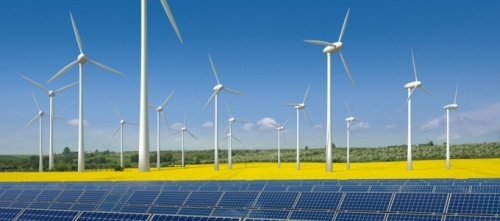

The renewable energy sector supplied an estimated 16 per cent of global energy last year and has continued to perform well despite the global economic slowdown, cuts in incentives, and low natural-gas prices, according to a United Nations-backed report. The sector also delivered close to 20 per cent of the world’s electricity production, according to the report commissioned by the Renewable Energy Policy Network for the 21st Century (REN21), whose secretariat is supported by the UN Environment Programme (UNEP). (FROM UNEP & News Centre Sources)
Solar Generation:
“The global performance of renewable energy despite headwinds has been a positive constant in turbulent times,” said Mohamed El-Ashry, Chairman of REN21’s Steering Committee. “Today, more people than ever before derive energy from renewables as capacity continues to grow, prices continue to fall, and shares of global energy from renewable energy continue to increase.” Global solar power generation doubled last year compared to the previous year, thanks to government incentive programmes and the continued fall in the price of Photovoltaic (PV) solar panels, according to the “Renewables 21: Global Status Report.” Germany installed more PV in 2010 than the entire world added in 2009. PV markets in Japan and the United States almost doubled relative to 2009.
Policy & Investment Driven Growth:
Globally, wind power added the most new capacity, followed by hydropower and solar PV, but for the first time ever, Europe added more PV than wind capacity. Renewable energy policies continue to be the main driver of the renewable energy growth, according to the report. By early this year, at least 119 countries had some type of policy target or renewable support policy at the national level, more than doubling from 55 countries in early 2005. More than half of those countries are in the developing world.
Last year, investment reached a record $211 billion in renewables – about one-third more than the $160 billion invested in 2009 – and more than five times the amount invested in 2004. Funds invested in renewable energy companies, and in utility-scale generation and biofuel projects increased to $143 billion, with developing countries surpassing developed economies for the first time.
Developing Countries Catching-up:
“The increased renewable energy activity in developing countries highlighted in this year’s report is very encouraging, since most of the future growth in energy demand is expected to occur in developing countries,” said Mr. El-Ashry. “More and more of the world’s people are gaining access to energy services through renewables, not only to meet their basic needs, but also to enable them to develop economically,” he added.
Further highlights from the Report:
*Renewable capacity now comprises about a quarter of total global power-generating capacity and supplies close to 20% of global electricity, with most of this provided by hydropower.
*Developing countries (collectively) have more than half of global renewable energy power.
*Solar PV capacity was added in more than 100 countries.
*The top five countries for non-hydro renewable power capacity were the United States, China, Germany, Spain, and India.
*In the United States, renewables accounted for about 10.9% of U.S. domestic primary energy production (compared with nuclear's 11.3%), an increase of 5.6% over 2009.
*In the United States, 30 states (plus Washington, D.C.) have Renewable Portfolio Standards (RPS).
*China led the world in the installation of wind turbines and solar thermal systems and was the top hydropower producer in 2010. The country added an estimated 29 GW of grid-connected renewable capacity, for a total of 252 GW, an increase of 13% compared with 2009.
*Renewables accounted for about 26% of China's total installed electric capacity in 2010, 18% of generation, and more than 9% of final energy supply.
*Brazil produces virtually all of the world's sugar-derived ethanol, and has been adding new hydropower, biomass and wind power plants, as well as solar heating systems.
*In the European Union, renewables represented an estimated 41% of newly installed electric capacity. While this share was significantly lower than the more than 60% of new capacity in 2009, more renewable power capacity was added in Europe than ever before.
*The EU exceeded its 2010 targets for wind, solar PV, concentrating solar thermal power, and heating/heat pumps. Countries including Finland, Germany, Spain, and Taiwan raised their targets, and South Africa, Guatemala, and India, among others, introduced new ones.
*Developing countries, which now represent more than half of all countries with policy targets and half of all countries with renewable support policies, are playing an increasingly important role in advancing renewable energy.
Related Report -
diplomaticallyincorrect.org/films/blog_post/surge-in-green-energy-investments-by-ambassador-mo/30927
FILM REPORT – “Germany/Merkel-Green Energy” -
diplomaticallyincorrect.org/films/movie/germanymerkel-green-energy/27787
By Ambassador Muhamed Sacirbey
Facebook Become a Fan – “Diplomatically Incorrect”
Twitter Follow us - DiplomaticallyX
More at Ecology-Diplomat -
diplomaticallyincorrect.org/c/ecology-diplomat/most_recent/1



